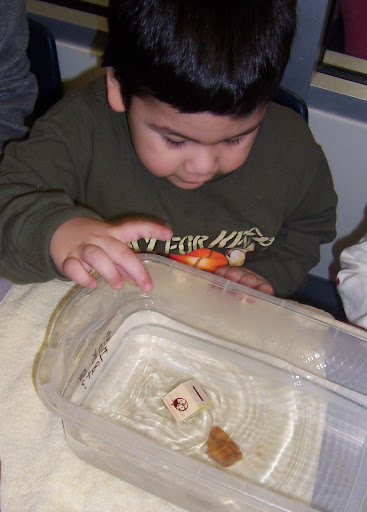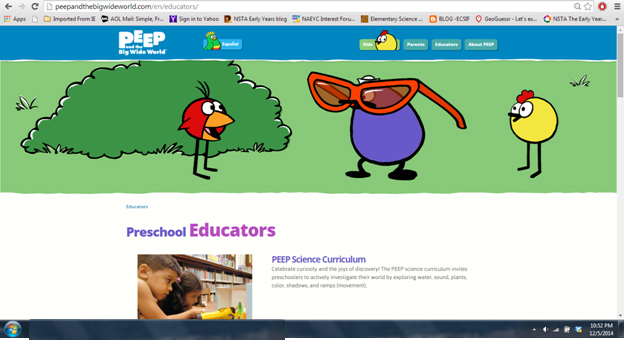What will happen if I…. Preparing an effective learning environment with help from Peep
By Peggy Ashbrook
Posted on 2014-12-05
 I see it all the time, children wondering what will happen if I….push on this ball, let go of this ball, put this ball in water, or throw this ball? What will happen if I…touch the paper gently with the paintbrush, shake the paint brush, put the brush all the way into the paint or put the brush into a different color? And what will happen if I blow into my straw, if I crush a strawberry in my hand or if I mix my food together?
I see it all the time, children wondering what will happen if I….push on this ball, let go of this ball, put this ball in water, or throw this ball? What will happen if I…touch the paper gently with the paintbrush, shake the paint brush, put the brush all the way into the paint or put the brush into a different color? And what will happen if I blow into my straw, if I crush a strawberry in my hand or if I mix my food together?
Causing something to happen is a goal of many early childhood investigations. An interesting environment provides many opportunities for children to wonder and act. As children investigate, we can support them. Follow along with blogger Denita Dinger on Play Counts! as she prepares the environment to invite exploration.
Following up on these open-ended investigations with conversations, discussions and revisiting the action can help children think more about what they did, what they thought would happen, what did happen and about any relationships involved.
 The Thinking BIG Learning BIG Facebook page by the author of Thinking Big Learning Big, Marie Faust Evitt, is a great source of inspiration for activities where children explore “what if’s.” In the November 2014 issue of Science and Children I wrote about Cause and Effect, one of the Crosscutting Concepts that support the Next Generation Science Standards (K-12) (NGSS) and an activity involving slightly inclined tabletops and balls. Setting up a table (without the children seeing me) so one end is lower gave children a puzzling situation to discuss and look for answers—the balls that were simply placed on the table began to move “all by themselves,” without being pushed! The children proposed relationships between the event (ball rolling “by itself”) and its cause. As they wondered about the cause, they thought of trying the balls on different tables to see if the same relationship exists.
The Thinking BIG Learning BIG Facebook page by the author of Thinking Big Learning Big, Marie Faust Evitt, is a great source of inspiration for activities where children explore “what if’s.” In the November 2014 issue of Science and Children I wrote about Cause and Effect, one of the Crosscutting Concepts that support the Next Generation Science Standards (K-12) (NGSS) and an activity involving slightly inclined tabletops and balls. Setting up a table (without the children seeing me) so one end is lower gave children a puzzling situation to discuss and look for answers—the balls that were simply placed on the table began to move “all by themselves,” without being pushed! The children proposed relationships between the event (ball rolling “by itself”) and its cause. As they wondered about the cause, they thought of trying the balls on different tables to see if the same relationship exists.
 On the Peep and the Big Wide World website, a video clip taken in a family child care shows children investigating how different inclined plane (ramp) surfaces affect the movement of objects. Peep and the Big Wide World is an animated television series and a website with really good professional development resources for early childhood educators, guided by the Science Adviser, Karen Worth. The video clips on the topics of Science Talk, Learning Environments, Individualized Instruction, and Documentation and Reflection are my favorite part of the extensive library that includes curriculum on the topics of color, plants, ramps, shadows, sound, and water. A Self-Guided training handout and Facilitator’s Guide and PowerPoint slides generously show how to deepen one’s own and other’s understanding of the strategies in the curriculum units.
On the Peep and the Big Wide World website, a video clip taken in a family child care shows children investigating how different inclined plane (ramp) surfaces affect the movement of objects. Peep and the Big Wide World is an animated television series and a website with really good professional development resources for early childhood educators, guided by the Science Adviser, Karen Worth. The video clips on the topics of Science Talk, Learning Environments, Individualized Instruction, and Documentation and Reflection are my favorite part of the extensive library that includes curriculum on the topics of color, plants, ramps, shadows, sound, and water. A Self-Guided training handout and Facilitator’s Guide and PowerPoint slides generously show how to deepen one’s own and other’s understanding of the strategies in the curriculum units.
Using these kinds of resources helps me create effective learning environments that encourage science exploration.
Disclaimer: The views expressed in this blog post are those of the author(s) and do not necessarily reflect the official position of the National Science Teaching Association (NSTA).


